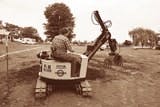When P&H described its new Stik-Clam hydraulic excavator in a 1965 sales brochure as "absolutely nothing like it," the statement was perfectly true — there was nothing like it on the market. As probably the world's first hydraulic mini excavator, it was equipped with a clamshell on a sliding arm mounted on a boom, instead of the usual backhoe attachment most familiar today. It was also likely the first ever zero-tail-swing excavator.
Known as the P&H model S-20 Stik-Clam, the compact excavator was built by Harnischfeger Corp. of Milwaukee, Wis., a company better known for its massive mining shovels, draglines and blast hole drills. The machine was so advanced for its day that the observer can be forgiven for mistaking it for a new product. In fact, when Dave Geis, whose restored Stik-Clam appears in the photograph, recently demonstrated it at a Historical Construction Equipment Association exposition, more than one observer was heard to say: "Is that a prototype machine from P&H?" and "When are they bringing it out on the market?"
The Stik-Clam boasted features like a hydraulic swing motor with 360-degree continuous rotation, double-acting bucket cylinder, a propel motor in each crawler assembly providing independent power steering, and a patented swivel block to rotate the clam in any position. These are features we've come to expect from any hydraulic excavator today, but in 1965, they were the latest technology. The sliding arm was driven by chain and hydraulic motor. The rotating clam enabled the machine to dig flush against buildings or underneath obstructions in the trench. The machine was advertised as ideal for residential and commercial builders, septic-tank excavation, nurseries, cemeteries, and for all underground services.
Specifications show an operating weight of 4,200 pounds, and a 24-horsepower Wisconsin air-cooled gasoline engine provided power for a 27-gpm hydraulic pump. This generated hydraulic pressure at 1,800 psi for all machine functions. The clamshell capacity was rated at two cubic feet, and the machine could lift a load of 500 pounds at an eight-foot radius. The hydraulically driven, six-foot-long undercarriage embodied eight bottom rollers as well as driving sprocket and main idler. With 10.5-inch shoes, the machine exerted a low 3.7 psi on the ground.
P&H provided an interesting option in the form of a trailer designed specifically to transport the Stik-Clam. P&H claimed the machine could be loaded and ready to go within two minutes; then hauled at speeds up to 60 mph behind a regular pickup truck. The machine was driven on board with the trailer in the tilted position, and secured in position with special safety locks built into the trailer.
The Stik-Clam demonstrated great potential. P&H's vision for a zero-tail-swing excavator in a compact size was certainly accurate, but here was another classic case of a machine too far ahead of its time. With little interest expressed by contractors, the Stic-Clam was withdrawn from the market in 1966, just one year after its introduction. Two decades later, the mini-excavator concept took hold and now has become one of the most popular compact machines.
Click here for more information
Read more about the evolution of construction equipment in Keith Haddock's fully illustrated book, The Earthmover Encyclopedia now available in bookstores. Also, consider a membership in the Historical Construction Equipment Association, www.hcea.net. And be sure to visit ConstructionEquipment.com for past Iron Works features.





